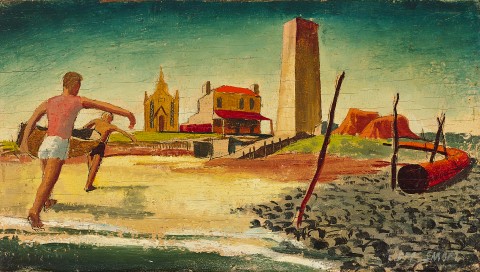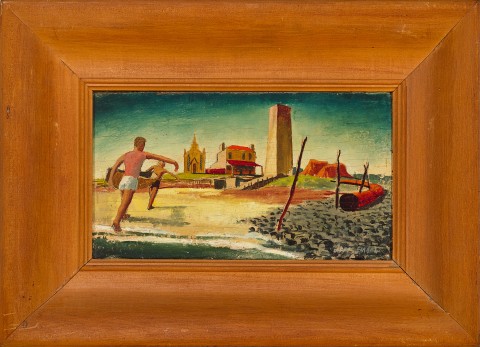Study for Wallaroo, 1951
Jeffrey Smart
oil on plywood
13.0 x 23.0 cm
signed lower right: Jeff Smart
inscribed verso: “WALLAROO”
George Page Cooper, Melbourne
Leonard Joel, Melbourne, 3 November 1993, lot 46
Private collection, Melbourne
Wallaroo, 1951, oil on plywood, 68.4 x 107.0 cm, National Gallery of Australia, Canberra
Large Study for Wallaroo, 1951, pen, ink and watercolour wash on paper, 31.0 x 48.0 cm, National Gallery of Australia, Canberra
Wallaroo VI, 1951, drawing in pen, ink wash, gouache, 29.0 x 48.2 cm, National Gallery of Australia, Canberra
We are grateful to Stephen Rogers, Archivist for the Estate of Jeffrey Smart, for his assistance with this catalogue entry.
1.jpg

The following excerpts are from Deborah Hart’s discussion of Wallaroo, 1951 (for which this lot is the study) in ‘Wallaroo: A Summation and Farewell’ in Jeffrey Smart, National Gallery of Australia, Canberra, 2021, pp. 82 – 87:
‘Jeffrey Smart’s Wallaroo, 1951 is a painting of utmost clarity and poise. It embodies a rhythmic swing in the dynamic of two boys carrying a boat, echoed by the posts rising in the foreground and the dramatic arc of the pipeline emerging from the edge of a cluster of rocks, leading our vision around to the background. There is an insistent doubling of forms across the scene, like notes that rise and fall between the spaces of a musical composition. The slender figure stepping out of from the water’s edge holds his arm out in a balletic pose for balance. It becomes another curing line, a gesture akin to floating in air like the boat itself. The luminous beach is the open terrain into which the figures enter, moving towards architectural structures positioned like stage props in the background. The figures seem held in time; the haunting stillness gently amplified by the orb of the moon, ‘a note against a plain surface’ that inevitably adds to the romanticism of the whole conception as an evocation of being and becoming, held in equilibrium.
…[The work] came into being during the course of visiting the copper mining town of Wallaroo on the Spencer Gulf coast of South Australia where he spent time in the landscape undertaking pencil drawings and watercolour studies. In this environment, he discovered the ruins and wreckage of the old mines, ‘great mounds of earth thrown up, making small mountains of different colours’, and old buildings constructed by Cornish immigrants in the nineteenth century. Smart felt the best way to arrive at a conception for the painting was to spend time ‘just to get the feel of this town’, noting how different sights made their way into sketches, with elements extracted and reoriented in the final composition…
Looking back, Wallaroo represented the culmination of much of what Smart had learned and been working towards over the previous decade: in its earthly palette, painterly brushwork and engagement with the local South Australian landscape. The bold shapes and underlying geometry were informed by Dorrit Black’s teachings and her introduction of dynamic symmetry and the golden mean, linking the art of the past with modern artists like Paul Cézanne and Fernand Léger…[Meanwhile] the underlying classicism in the work, relating to harmony and balance, was informed by his keen interest in the ancient world which came to the fore during 1950 while he was living on the island of Ischia and spending time visiting Greek temples, as well as making regular trips to the Naples National Archaeological Museum.
…Ultimately the painting is an amalgam of multiple overlapping currents of interest for a burgeoning artist on the cusp of new discoveries. At 30 years of age, it is testimony to the fact that he recognised his path forward was to distil what he later often described as ‘crystalline clarity’ out of complexity. As the last direct engagement in his art of this period with the South Australian landscape, Wallaroo can be considered an evocative farewell painting to Smart’s place of origin and a work of key significance in his artistic development.’


